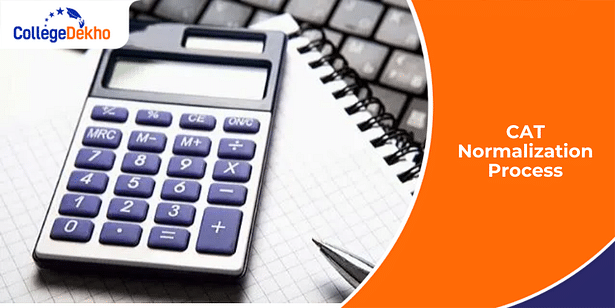
The CAT Normalization Process 2025 ensures that all candidates are evaluated fairly, regardless of the slot they appear in. Since the CAT 2025 exam will be held in three separate sessions on November 30, 2025 , the difficulty level of each paper may differ slightly. To maintain equality among all test-takers, the Indian Institute of Management (IIM) uses a normalization method that adjusts raw scores for variations in difficulty across different slots. This normalization, also called the scaling or equating process, aligns scores statistically by considering both location and scale differences across test versions. It ensures that a candidate’s performance reflects ability rather than slot difficulty. Once the slot-wise normalization is completed, section-wise scaling is applied to maintain consistency across all areas. CAT 2025 will take place in around 170 cities across India.
Also Read:
| List of Non-IIM MBA Colleges to Apply to Before and After CAT 2025 Exam |
|---|
How is CAT 2025 Normalisation Calculated?
The CAT Normalization Process is carried out in two steps.
- In the first step of the CAT normalization process, IIMs adjust the exam scores for 'scale differences of score distribution across different question papers'.
- In the second step, after the normalization process has been applied across different question papers, the scores across different sections are normalized.
After a candidate has attempted the CAT question paper, their 'Raw Scores' are calculated, which are based purely on the number of correct answers and the number of wrong answers in the CAT exam. To calculate the raw score, a candidate must know the:
- CAT Marking Scheme (+3, -1)
- No. of Correct Answers
- No. of Incorrect Answers
Raw Scores in CAT can be calculated by using the following formula.
Raw Score = 3 x (No. of Correct Answers) - 1 x (No. of Incorrect Answers) |
|---|
Once the raw scores have been calculated, the CAT normalization process can be applied to get the Scaled Score of a candidate in the CAT. The CAT scorecard, which is released with the declaration of CAT Results, contains the scaled scores of a candidate. The CAT percentile, whether it be overall or section-wise, is also calculated using the CAT scaled scores.
Also Read: MBA Admission Process 2026
Importance of Normalization in CAT 2025
Candidates appearing in different shifts get different question papers for CAT. Even though the conducting body, i.e. IIMs, ensures that the question papers are identical in their difficulty level, there may be some discrepancies in the difficulty level of question papers or test forms. Hence, a probability arises that candidates of one slot may get an easier question paper than candidates of the other slot. To nullify this advantage, IIMs employ the CAT Normalization process. It is the adjustment made in the CAT score of participants to ensure that there is no discrimination for or against any candidate in the calculation of final CAT scores. The normalised CAT 2025 result is a very important factor in the overall CAT selection process 2025 as well.
What is the Scaled Score in CAT 2025?
The CAT exam is conducted in multiple sessions (two or three). Since the question paper for each session is slightly different from one another, a scaled score is produced through the CAT normalization process to ensure fairness and equality in the performance comparison of all candidates. This scaled score could vary in different ways from the raw score.
Revised CAT Scaled Score Calculation
Since CAT 2025 is being conducted in 3 shifts, the following information has been updated to account for the same.
The scaled score of CAT is calculated across each section of the exam. Once the scaled score of each section has been calculated, the overall score can be calculated by simply adding up the scaled scores of each section.
In order to easily understand the process of normalization of CAT scores, it is better to break down the process into multiple steps and understand each variable that is used in the formula. Let's first understand the steps to calculate the CAT scaled score, and then we will take a look at the formula.
These steps are applied section-wise i.e. raw scores of only one section are considered at a time when calculating scaled scores.
Step 1: Mean (Average) and Standard Deviation (SD) of the raw scores of candidates who appeared in the 1st shift are calculated and added together.
M1 = Mean of 1st Shift + SD of 1st Shift |
|---|
Step 2: The Mean and SD of the raw scores of candidates who appeared in the 2nd shift are calculated and added together.
M2 = Mean of 2nd Shift + SD of 2nd Shift |
|---|
Step 3: Mean and SD of the raw scores of candidates who appeared in the 3rd shift are calculated and added together.
M3 = Mean of 3rd Shift + SD of 3rd Shift |
|---|
Step 4: The Mean and SD of the raw scores of all of the candidates who appeared across all three of sections are calculated.
M = Mean of all three shifts + SD of all three shifts |
|---|
Step 5: The Mean of the raw scores of the top 0.1% of the candidates who appeared in the 1st shift is calculated.
Let this be M1.01 |
|---|
Step 6: The Mean of the raw scores of the top 0.1% of the candidates who appeared in the 2nd shift is calculated.
Let this be M2.01 |
|---|
Step 7: The Mean of the raw scores of the top 0.1% of candidates from the 3rd shift is calculated.
Let this be M3.01 |
|---|
Step 8: The Mean of the raw scores of the top 0.1% of the candidates across both sections is calculated.
Let this be M0.1 |
|---|
Step 9: The following formula is used to calculate the scaled score of a candidate. Please note that the given formula is for a candidate who appeared for the 1st shift.
Scaled Score = M + {(R - M1) x (M0.1 - M) / (M1.01 - M1)} |
|---|
The relevant values in this formula must be changed accordingly to calculate the scaled score of a candidate in the other two shifts.
Here, R is the Raw Score of the candidate whose scaled score is being calculated.
Overall Scaled Score = Scaled Score in DILR + Scaled Score in QA + Scaled Score in VARC |
|---|
Also Read:
How Do IIMs Calculate CAT Composite Score?
The CAT composite score is an essential factor in evaluating a candidate's overall profile for admission into MBA programs offered by the IIMs. While the CAT score is significant, the composite score considers other factors such as academic background, work experience, extracurricular activities, and diversity. It's worth noting that candidates with similar CAT scores may still have different composite scores due to differences in these parameters. The composite score provides a comprehensive assessment of a candidate's potential for admission into IIMs. Below are the parameters considered when calculating the CAT composite score:
Class 10th Marks
Class 12th Marks
Graduation Percentage/ Grade
Work Experience
Academic Background
Gender Diversity
How Is the CAT Composite Score Calculated?
The CAT composite score is calculated by IIMs using the following formula:
Also Check: What After CAT 2025 Exam?
How is CAT 2025 Percentile Calculated?
A CAT percentile shows what percentage of candidates have received a score higher than yours in the CAT exam. To calculate the CAT percentile, it is important to know two things:
- Your rank in CAT (R)
- Total no. of candidates who appeared for CAT (N)
The steps outlined below are used to compute a candidate's CAT 2025 overall and sectional percentile scores. The QA section is used as an example to demonstrate the percentile score calculating method.
- Step 1: The total number of appearing candidates(N) for CAT is taken into account. It includes the morning, afternoon, and evening sessions.
- Step 2: A rank (r) is assigned to all the candidates who appeared for CAT 2025, depending on the computed scores obtained in the QA section. In a scenario where two/more candidates have obtained identical scaled scores in the QA section, identical ranks are assigned to all such candidates. For instance, let's suppose that exactly two candidates have obtained the highest scaled score in the QA section. In this case, both candidates are allocated a rank of 1. Furthermore, the candidate(s) securing the second-highest scaled score in the QA segment are assigned a rank of 3, and so on.
- Step 3: The candidate's percentile score (P) is calculated with rank (r) in the QA section like this:
P = [(N-r) N] 100 |
|---|
Step 4: The candidate's estimated percentile score (P) should then be rounded off to the nearest two decimal places.
Every CAT 2025 aspirant should be aware of the CAT normalization process to understand how their percentile scores are calculated. For any queries related to CAT 2025, students can write to us at the CollegeDekho QnA Zone . You can even check our CAT College Predictor 2025 and CAT Percentile Predictor 2025 tools to get an idea of your results based on your performance in the CAT 2025 exam. For admission-related assistance, call our toll-free number 1800-572-9877, or fill out our Common Application Form (CAF) .
Are you feeling lost and unsure about what career path to take after completing 12th standard?
Say goodbye to confusion and hello to a bright future!

FAQs
To calculate a normalized CAT score, your raw scores for each section are scaled using a formula that takes into account the mean and standard deviation of raw scores from both your specific test slot and the overall test. This adjusted or scaled score is then used to determine your percentile rank.
The CAT normalization process includes steps such as calculating the raw scores and then converting the raw scores to adjust slot adjustments. Finally, the converted scores are used to calculate the CAT 2025 percentile.
Yes, normalization can lead to a decrease in marks because it is a statistical process aimed at equalizing scores across test sessions with varying difficulty levels, rather than just adjusting scores by adding or subtracting points. However, the normalization of the CAT scores is done to make the score assessment fair for all; therefore, the normalization process doesn’t make much difference to the relative CAT percentile.
The CAT normalization process involves adjusting for variations in location and scale across the score distributions of different question papers. The scaled scores derived from this adjustment are then converted into CAT percentiles.
One of the biggest advantages of CAT normalization is that the CAT authorities are able to guarantee that every candidate is assessed equally thanks to the CAT Normalisation Process. In every session, they ensure that the student performs with honesty and integrity. They will therefore receive their score as a unique percentile via the CAT Normalisation Process. The official information provided by the CAT Authorities states that the scores are often normalized multiple times.
The CAT score is calculated using different methods and conversions like the CAT normalization process. A candidate's CAT rank is based on the CAT scaled score or the total number of candidates. CAT normalisation process formula is as follows: Raw Score = 3 x (No. of correct answer) - 1 x (No. of wrong answer).
The CAT 2026 composite score is mainly based on your scaled CAT exam score, which gets the highest weight. Additionally, your academic profile such as Class 10th, 12th marks, graduation marks, work experience, and diversity factors like gender and academic background add to this score. Each IIM may have slightly different weightages, but CAT score usually holds 40-60% weight in the composite score. The composite score combines these to shortlist you for further rounds like WAT and PI.
Yes, a decrease in the marks of CAT applicants who scored highly on the exam would be the consequence of the CAT normalization process in terms of actual exam results. However such candidates shouldn't worry about their grades because they passed the CAT exam.
Yes, accuracy is very important during the CAT normalization process. In order to determine the candidate's final percentile, the normalization process also takes into account the total of the mean and standard deviation of scores on a particular slot. Therefore, getting a particular number on the CAT exam is not as important as precision in the normalization procedure.
Several factors are taken into account while calculating the CAT scaled score. To calculate the normalized CAT scores, candidates must be aware of the raw scores of EVERY candidate who took the 2025 CAT exam. To determine their Scaled Scores, candidates must also possess knowledge of each other's CAT shifts. Since the normalization is done by the CAT conducting authorities, the CAT scorecard will also include a list of the sectional percentiles and overall scores.
The reason behind the CAT scaled score being so important is the CAT exam being conducted in two slots and in order for each student to receive the same marking standards. The IIMs do the CAT score computation using a candidate’s raw score as a basis. The score that results from the computation is therefore referred to as the scaled score. The score that shows up on the CAT scorecard is the scaled score. To put it briefly, the performance of an application is compared to that of other candidates for the same shift and others using CAT scaled scores.
The CAT scaled score is calculated using the CAT raw score. The average of a group of students' CAT results is known as a mean scale score. By adding up each individual student's score and dividing by the entire number of scores, one may calculate the mean scaled score. The scaled score for each of the three sections will be determined using an identical procedure to calculate the CAT scaled score. For example, the total scaled score is equal to the sum of the scaled scores for VARC, QA, and DILR.
The CAT normalization process is used to ensure fairness and standard evaluation of all CAT candidates. The goal of the CAT Normalisation approach is to ensure that candidates do not gain or lose anything from presenting in different shifts. Assessments for applicants become more equitable with the use of normalisation. Owing to inevitable human error, question papers from different shifts have slightly differing levels of difficulty.
The CAT normalization process is a method used to make sure that all CAT candidates are marked using the same evaluation standards. Raising or lowering the CAT marks that students get in discrete, timed sessions to a predetermined total is known as "normalization of marks." Students who were awarded 30 points in the first session of the exam because of its higher difficulty will awarded 60 points through normalization. The CAT exam is administered over the course of two or three sessions. Since every session's question paper is unique, the CAT normalization method creates a scaled score to guarantee equity and fairness in comparing each applicant's performance.
Was this article helpful?





















Similar Articles
Mistakes to Avoid on SNAP 2025 Exam Day
SNAP 2025 Last Minute Tips - Check What to Do in Last Few Days of SNAP Preparation
SNAP 2025 Exam Day Guidelines: Documents to Carry, Instructions, Things to Avoid
How to Approach SNAP 2025 Question Paper: Smart Strategies for Your Question Paper Approach
CMAT 2026 Preparation Tips for General Awareness (GK): Important Topics, Sample Questions
CMAT 2026 Percentile vs College